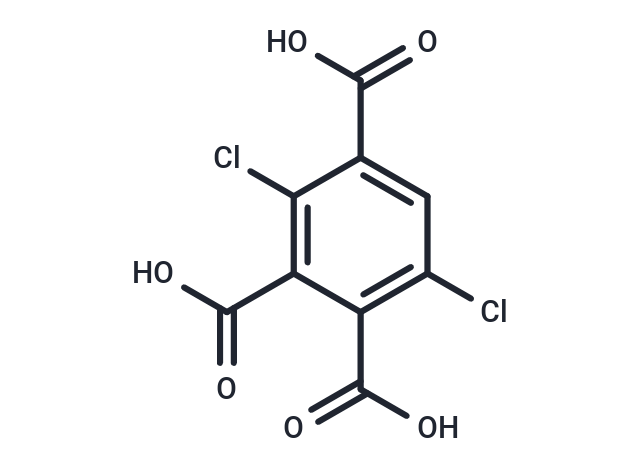Shopping Cart
Remove All Your shopping cart is currently empty
Your shopping cart is currently empty
3,6-Dichlorotrimellitic acid serves as the fundamental precursor for the synthesis of numerous dichlorinated fluoresceins and rhodamines.

| Pack Size | Price | USA Warehouse | Global Warehouse | Quantity |
|---|---|---|---|---|
| 25 mg | $41 | In Stock | In Stock | |
| 50 mg | $59 | In Stock | In Stock | |
| 100 mg | $90 | In Stock | In Stock | |
| 500 mg | $223 | - | In Stock | |
| 1 mL x 10 mM (in DMSO) | $29 | In Stock | In Stock |
| Description | 3,6-Dichlorotrimellitic acid serves as the fundamental precursor for the synthesis of numerous dichlorinated fluoresceins and rhodamines. |
| Cell Research | Instructions I. Solution preparation 1. Stock solution: Dissolve 3,6-Dichlorotrimellitic acid in an appropriate solvent (such as anhydrous DMF or DMSO) to prepare a stock solution with a concentration of 1-10 mM. 2. Working solution: Dilute the stock solution to an appropriate working concentration, usually 10-100 µM, according to experimental needs. PBS (pH 7.4) or other suitable buffers can be used. II. Application steps a. Synthesis of fluorescein chloride or rhodamine derivatives (1) React 3,6-Dichlorotrimellitic acid with aminofluorescein or aminorhodamine, usually in an anhydrous solvent. (2) Reaction conditions: The common reaction temperature is 50-70°C and the reaction time is 2-6 hours. After the reaction is completed, use an appropriate solvent (such as methanol or water) for purification. (3) The obtained product can be used to label DNA or oligonucleotides. b. Labeling oligonucleotides or DNA (1) React the synthesized dichlorofluorescein or rhodamine derivatives with the target oligonucleotide or DNA. (2) Use chlorofluorescein or rhodamine to bind to amino groups or other functional groups in nucleic acids by covalent binding. (3) Reaction time: usually 1-2 hours, temperature controlled at 4°C. (4) After the reaction is completed, purify the labeled DNA or oligonucleotide by gel electrophoresis or liquid chromatography. c. Calibration and control Control group: Set up unreacted fluorescent dye or unlabeled DNA as a control to ensure the specificity of the labeling. Standard curve: Use a known concentration of labeled DNA sample to establish a standard curve between the fluorescence signal and the DNA concentration. Precautions (1) Photosensitivity: 3,6-Dichlorotrimellitic acid and its derivatives chlorofluorescein and rhodamine are generally highly photosensitized and should be avoided from direct exposure to strong light. (2) Storage conditions: 3,6-Dichlorotrimellitic acid and its derivatives should be stored at -20°C, away from light to prevent degradation. (3) Solubility: 3,6-Dichlorotrimellitic acid may release chlorine gas when dissolved. Experiments should be carried out in a well-ventilated environment. |
| Molecular Weight | 279.03 |
| Formula | C9H4Cl2O6 |
| Cas No. | 137071-78-4 |
| Smiles | OC(=O)c1cc(Cl)c(C(O)=O)c(C(O)=O)c1Cl |
| Relative Density. | 1.848 g/cm3 |
| Storage | keep away from direct sunlight | Powder: -20°C for 3 years | In solvent: -80°C for 1 year | Shipping with blue ice/Shipping at ambient temperature. | |||||||||||||||||||||||||||||||||||
| Solubility Information | DMSO: 60 mg/mL (215.03 mM), Sonication is recommended. | |||||||||||||||||||||||||||||||||||
| In Vivo Formulation | 10% DMSO+40% PEG300+5% Tween-80+45% Saline: 2.5 mg/mL (8.96 mM), Sonication is recommeded. Please add the solvents sequentially, clarifying the solution as much as possible before adding the next one. Dissolve by heating and/or sonication if necessary. Working solution is recommended to be prepared and used immediately. The formulation provided above is for reference purposes only. In vivo formulations may vary and should be modified based on specific experimental conditions. | |||||||||||||||||||||||||||||||||||
Solution Preparation Table | ||||||||||||||||||||||||||||||||||||
DMSO
| ||||||||||||||||||||||||||||||||||||
| Size | Quantity | Unit Price | Amount | Operation |
|---|

Copyright © 2015-2026 TargetMol Chemicals Inc. All Rights Reserved.